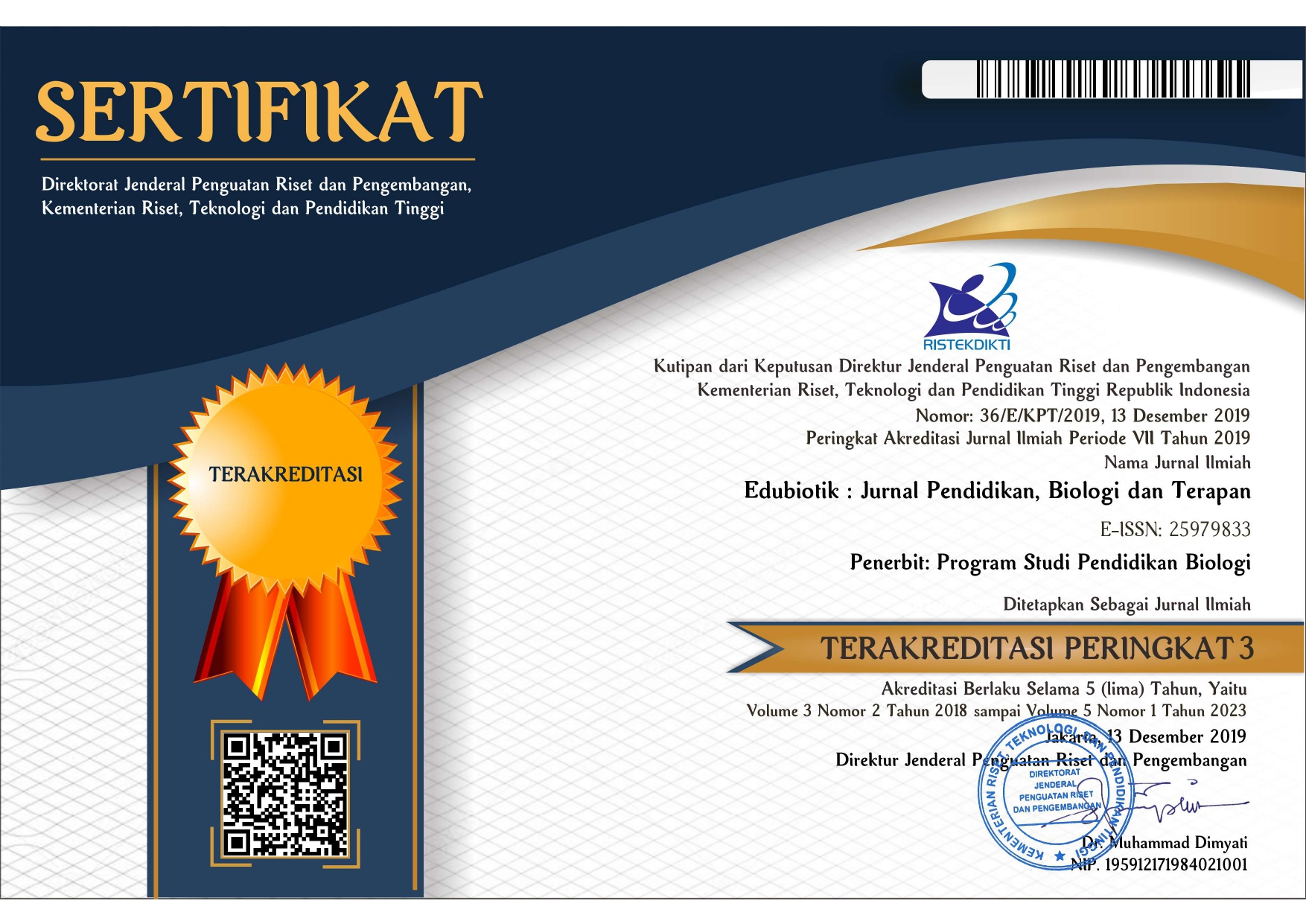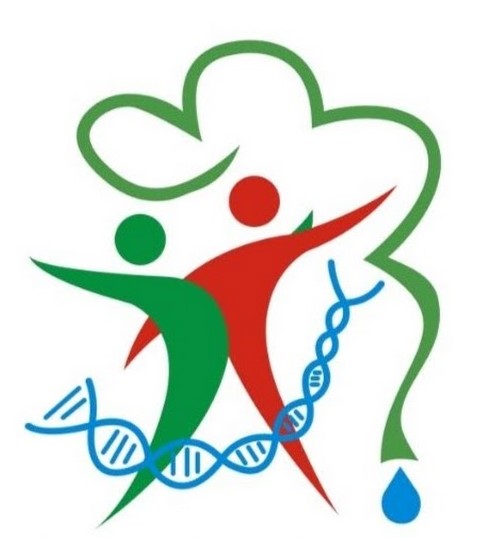Development of PBL-based lichens diversity e-module to improve students' problem-solving skills
Abstract
Problem-solving skills are important things everyone needs to have to improve their quality of life. The results of a needs analysis carried out on Biology students at the State University of Malang show that their problem-solving abilities are still relatively low in lichen diversity material. This research aims to determine the development of PBL-based lichens diversity e-module and its influence on students' problem-solving skills completeness e-module and its effect on students' problem-solving skills. This type of research is a development study (development research) with the ADDIE development model. This research was conducted at the State University of Malang in biology class with a sample size of 67 students. The research instrument uses problem-solving pretest and posttest sheets, as well as material expert questionnaires, media expert questionnaires, and practicality questionnaires from educators who will use the e-module. Data were analyzed using Analysis of Covariance (ANCOVA). The results showed that the e-module developed was a very good product and could be used in learning Lichen material. The results of the study stated that the e-module was effective in improving problem-solving skills (sig. ˂ 0.05). So, it can be concluded that the PBL-based e-module is effective for improving problem-solving skills in biology students of the State University of Malang.
References
Arsyad, A. (2013). Media pembelajaran. Rajawali Pers.
Ashari, N. W., & Salwah, S. (2017). Problem Based Learning (PBL) dalam Meningkatkan Kecakapan Pembuktian Matematis Mahasiswa Calon Guru. JMPM: Jurnal Matematika Dan Pendidikan Matematika, 2(2), 100-109. https://doi.org/10.26594/jmpm.v2i2.891
Asrial, A., Syahrial, S., Kurniawan, D. A., & Saputri, J. (2021). E-Module Based on Local Wisdom Ngubat Padi Improves Students’ Social Care Character. Jurnal Ilmiah Sekolah Dasar, 5(4), 579-587. https://doi.org/10.23887/jisd.v5i4.36206
Azeiteiro, U. M., Bacelar-Nicolau, P., Caetano, F. J. P., & Caeiro, S. (2015). Education for sustainable development through e-learning in higher education: Experiences from Portugal. Journal of Cleaner Production, 106, 308–319. https://doi.org/10.1016/j.jclepro.2014.11.056
Aziza, A. N., Helendra, Syamsurizal, Ardi, & Yogica, R. (2022). Validitas E-Modul Berbantuan Video Pembelajaran tentang Materi Jaringan Hewan untuk SMA. Ruang-Ruang Kelas:Jurnal Pendidikan Biologi, 2(1), 42–48. http://rrkjurnal.ppj.unp.ac.id/index.php/RRKJURNAL/article /view/51
Cahyani, A. (2022). Penyusunan bahan ajar berupa modul berbasis kontekstual pada konsep keanekaragaman hayati untuk siswa kelas X. Jurnal Biologi Dan Pembelajarannya, 17(1), 143-151. https://jurnal.untirta.ac.id/index.php/biodidaktika/article/view/16113
Cahyani, H., & Setyawati, R. W. (2016). Pentingnya Peningkatan Kemampuan Pemecahan Masalah Melalui PBL untuk Mempersiapkan Generasi Unggul Menghadapi MEA. PRISMA, Prosiding Seminar Nasional Matematika, 151–160. https://www.semanticscholar.org/
Damayanti, J., Sueb, S., & Rohman, F. (2021). Students’ problem-solving skills through problem based learning module: Macrozoobenthos as bioindicator water quality module. AIP Conference Proceedings, 2330, 1–8. https://doi.org/10.1063/5.0043584
Dismarianti, I., Anggun, D. P., Riswanda, J., Maretha, D. E., & Ulfa, K. (2020). Pengembangan Media Pembelajaran Biologi Berbasis Modul Elektronik (E- Modul) pada Materi Struktur dan Fungsi Tumbuhan Kelas VIII SMP/MTS. Prosiding Seminar Nasional Pendidikan Biologi 2020, 110–119. http://proceedings.radenfatah.ac.id/index.php/semnaspbio/article/view/525#
Harrati, N., Bouchrika, I., Tari, A., & Ladjailia, A. (2016). Exploring user satisfaction for e-learning systems via usage-based metrics and system usability scale analysis. Computers in Human Behavior, 61, 463–471. https://doi.org/10.1016/j.chb.2016.03.051
Hudha, M. N., Aji, S., & Rismawati, A. (2017). Pengembangan Modul Pembelajaran Fisika Berbasis Problem Based Learning untuk Meningkatkan Kemampuan Pemecahan Masalah Fisika. SEJ (Science Education Journal), 1(1), 36–51. https://doi.org/10.21070/sej.v1i1.830
Indarta, Y., Jalinus, N., Samala, A. D., Riyanda, A. R., & Adi, N. H. (2022). Relevansi kurikulum merdeka belajar dengan model pembelajaran abad 21 dalam perkembangan era society 5.0. Edukatif, 4(2), 3011–3024. https://edukatif.org/index.php/edukatif/article/view/2589
Irmeilyana, I., Ngudiantoro, N., Affandi, A. K., Setiawan, A., & Windusari, Y. (2020). Pemanfaatan lingkungan alam sekitar sebagai sumber belajar dan media pembelajaran matematika, IPA, dan seni bagi pendidikan dan pengembangan kreatifitas anak di kecamatan Pemulutan Barat Kabupaten Ogan Ilir. Jurnal Vokasi, 4(1), 16-23. https://doi.org/10.30811/vokasi.v4i1.1578
Irwansyah, F. S., Lubab, I., Farida, I., & Ramdhani, M. A. (2017). Designing interactive electronic module in chemistry lessons. Journal of Physics: Conference Series, 895(1), 1-7. https://doi.org/10.1088/1742-6596/895/1/012009
Kahar, M. I., Cika, H., Nur Afni, & Nur Eka Wahyuningsih. (2021). Pendidikan era revolusi industri 4.0 menuju era society 5.0 di masa pandemi covid 19. Moderasi: Jurnal Studi Ilmu Pengetahuan Sosial, 2(1), 58–78. https://doi.org/10.24239/moderasi.vol2.iss1.40
Linda, R., Herdini, H., S, I. S., & Putra, T. P. (2018). Interactive e-module development through chemistry magazine on kvisoft flipbook maker application for chemistry learning in second semester at second grade senior high school. Journal of Science Learning, 2(1), 21-25. https://doi.org/10.17509/jsl.v2i1.12933
Maspupah, M., Alwahidah, I. R., & Sa’adah, S. (2020). Analisis kemampuan pemecahan masalah pada materi perubahan lingkungan dengan model pembelajaran problem solving. Jurnal Program Studi Pendidikan Biologi, 0417(1), 17–26. https://journal.uinsgd.ac.id/index.php/bioeduin/article/ view/8140
Mellisa. (2018). Analisis kemampuan pemecahan masalah mahasiswa program studi pendidikan biologi FKIP UIR pada mata kuliah fisiologi tumbuhan tahun ajaran 2015 / 2016. Journal Indonesian Biology Teachers, 1(2), 47–52. https://ibt.ejournal.unri.ac.id/index.php/%20IBT/article/ view/6210/5698
Memnun, D. S., Har, L. C., & Akkaya, R. (2012). A research on the mathematical problem solving beliefs of mathematics, science and elementary pre-service teachers in Turkey in terms of different variables. International Journal of Humanities and Social Science, 2(24), 172–184. https://api.semanticscholar.org/CorpusID:124313943
Muslim, & Hasairin, A. (2018). Eksplorasi lichenes pada tegakan pohon di area taman margasatwa (Medan Zoo) Simalingkar Medan Sumatera Utara. Jurnal Biosains, 4(3), 145–153. https://jurnal.unimed.ac.id/2012/index.php/biosains/article/view/9715
Nariswari, N. P., Hidayat, S., Hariz, A. R., Islam, U., & Walisongo, N. (2022). Pengembangan e-flipbook materi perubahan lingkungan berbasis literasi lingkungan sebagai sumber belajar biologi pada siswa SMA / MA. NCOINS: National Conference Of Islamic Natural Science, 81–94. https://proceeding.iainkudus.ac.id/index.php/NCOINS/article/view/339
Nia, N., Leksono, S. M., & Nestiadi, A. (2022). Pengembangan e-modul pelestarian lingkungan berbasis problem based learning (pbl) untuk meningkatkan kemampuan berpikir kritis siswa SMP. PENDIPA Journal of Science Education, 6(2), 415–421. https://doi.org/10.33369/pendipa.6.2.415-421
Özgenel, M. (2018). Modeling the relationships between school administrators’ creative and critical thinking dispositions with decision making styles and problem solving skills. Kuram ve Uygulamada Egitim Bilimleri, 18(3), 673–700. https://files.eric.ed.gov/fulltext/EJ1202184.pdf
Pramana, M. W. A., Jampel, I. N., & Pudjawan, K. (2020). Meningkatkan hasil belajar biologi melalui e-modul berbasis problem based learning. Jurnal Edutech Undiksha, 8(2), 17-32. https://doi.org/10.23887/jeu.v8i2.28921
Puspridayanti, V., Wedi, A., & Ulfa, S. (2018). Pengembangan e-module mata pelajaran biologi kelas xi semester ii materi sistem pernapasan manusia di SMA Negeri 1 Karangan Trenggalek. JINOTEP, 4(2), 56–62. https://doi.org/10.17977/um031v4i22018p056
Putri, A. S., & Aznam, N. (2019). The effect of the science web module integrated on batik’s local potential towards students’ critical thinking and problem solving (thinking skill). Journal of Science Learning, 2(3), 92–96. https://doi.org/10.17509/jsl.v2i3.16843
Rahima, R., & Putra, A. P. (2022). Validitas dan keterbacaan peserta didik kelas x sma terhadap pengembangan modul elektronik berbasis flip html5 konsep protista. Jurnal Pendidikan Universitas Garut, 16(1), 570–580. http://dx.doi.org/10.52434/jp.v16i1.1828
Ramadayanty, M., Sutarno, S., & Risdianto, E. (2021). Pengembangan e-modul fisika berbasis multiple reprsentation untuk melatihkan keterampilan pemecahan masalah siswa. Jurnal Kumparan Fisika, 4(1), 17–24. https://doi.org/10.33369/jkf.4.1.17-24
Situmorang, R. P. (2016). Analisis potensi lokal untuk mengembangkan bahan ajar biologi. Jurnal Pendidikan Sains, 4(1), 51–57.http://103.97.100.145/index.php/JPKIMIA/article/%20view/1938/19 78
Sudrajat, W., Setyawati, T. R., & Mukarlina. (2013). Keanekaragaman lichen corticolous pada tiga jalur hijau di Kabupaten Kubu Raya Wendi. Jurnal PROTOBIONT, 2(2), 75–79. https://adoc.pub/keanekaragaman-lichen-corticolous-pada-tiga-jalur-hijau-di-k.html
Suhartiwi, F., Islami, N., Fakhruddin, F., & Yennita, Y. (2019). The development of learning module environmentally friendly technologies based creative the problem solving. Journal of Physics: Conference Series, 1351(1). https://doi.org/10.1088/1742-6596/1351/1/012069
Sungkono. (2009). Pengembangan dan pemanfaatan bahan ajar modul dalam proses pembelajaran. Majalah Ilmiah Pembelajaran, 5–1. https://journal.uny.ac.id/index.php/mip/article/view/6154
Suyitno, I. (2012). Memahami Tindakan Pembelajaran. Refika Aditama.
Tripp, E. A., Lendemer, J. C., & McCain, C. M. (2019). Habitat quality and disturbance drive lichen species richness in a temperate biodiversity hotspot. Oecologia, 190(2), 445–457. https://doi.org/10.1007/s00442-019-04413-0
Vina Serevina, Sunaryo, Raihanati, I Made Astra, I. J. S. (2018). Development of e-module based on problem based learning (pbl) on heat and temperature to improve student’s science process skill. TOJET: The Turkish Online Journal of Educational Technology, 17(3), 26–36. https://eric.ed.gov/?id=EJ1184205
Wahyudyawati, E., & Amin, M. (2021). The effectiveness of guided inquiry learning e-module containing research result in bioethanol production from water Hyacinth to improve student environmental literacy. AIP Conference Proceedings, 2330. https://doi.org/10.1063/5.0043527
Wahyuni, L. (2021). Pengembangan e-book berbasis projectbased learning (pjbl) untuk melatihkan kemampuan berpikir kreatif pada materi pertumbuhan dan perkembangan tumbuhan kelas xii SMA. Bioedu, 10(2), 314–325. https://doi.org/10.26740/bioedu.v10n2.p314-325
Widya, W., Andriani, R., Sudirman, S., Hidayat, A. T., & Elisyah, N. (2023). The Effectiveness of physics e-modules based on creative problem-solving learning model integrated with 21st-century skills. Indonesian Journal of Science and Mathematics Education, 6(1), 48–58. http://ejournal.radenintan.ac.id/index.php/IJSME/article/view/14584/6132
Yokhebed. (2018). Peningkatan keterampilan pemecahan masalah melalui pembelajaran dengan modul berbasis potensi lokal pada calon guru biologi. Jurnal Pendidikan, 16(2), 235–243. https://doi.org/10.31571/edukasi.v16i2.966
Yoriska, V., & Ristiono. (2021). Pengembangan media pembelajaran biologi menggunakan google sites tentang materi sistem sirkulasi darah pada manusia untuk peserta didik kelas xi MIPA SMA. Biodidaktika: Jurnal Biologi Dan Pembelajarannya, 17(2), 55–61. https://jurnal.untirta.ac.id/index.php/biodidaktika/article/view/16498/9355
Yulinda, R., Sari, M. M., Hayati, F., & Rahman, A. (2022). Validitas dan praktikalitas buku ajar mikrobiologi berbasis proyek bioentrepreneurship. LENSA (Lentera Sains): Jurnal Pendidikan IPA, 12(2), 162–171. https://doi.org/10.24929/lensa.v12i2.231





.png)
2.png)

1.jpg)


